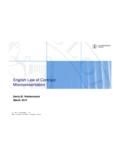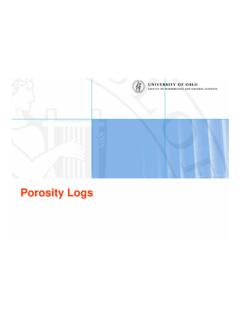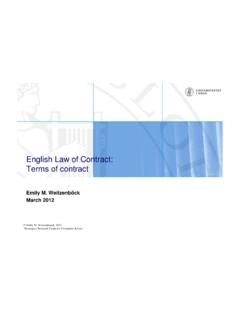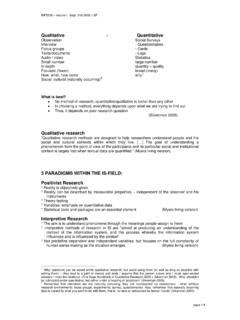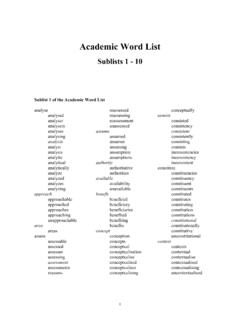Transcription of Chapter 1 What is language? - UiO
1 Chapter 1: What is language? Chapter 1. What is language? This book is an introduction to the study of human language across the planet. It is concerned with the immense variety among the languages of the world, as well as the common traits that cut across the differences. The book presents a number of analytic tools for comparing and contrasting different languages, and for seeing any one particular language in a larger linguistic perspective. The book attempts to avoid eurocentrism, the excessive focus on European languages often found in introductions to linguistics. Although, for ease of presentation, examples are often drawn from English, a large variety of languages from all continents are drawn into the discussion whenever this helps to broaden our perspective. This global focus is reflected in the choice of topics. Apart from a Chapter introducing the four traditional branches of linguistics (semantics, syntax, morphology and phonology), this book is primarily interested in the following seemingly simple questions: 1.
2 How and why do languages resemble each other? 2. How and why do languages differ from each other? These questions are dealt with, from different angles, in the chapters on language universals, linguistic typology, language families and language contact. The Chapter on language variation moves the focus from inter-language to intra-language comparison. Finally, the Chapter on writing discusses similarities and differences in the ways in which various cultures have used a visual medium to represent and augment the auditory signals of speech. The book is primarily concerned with natural languages that function as full- fledged mother tongues for larger or smaller groups of people. It is less concerned with the clearly artificial and highly restricted languages of, for instance, mathematics, formal logic or computer programming. The line of division is not always clear. While the word one belongs to English, the number 1 belongs to mathematics; and while the words if and then belong to English, the logical operator if-then belongs to formal logic and computer programming.
3 At the heart of our concern lies the spoken language. All natural languages are spoken, while to this day many of them have no written form. Unlike most textbooks in linguistics, however, this book will also devote a whole Chapter to writing, which may be seen as an extension of speech. On the other hand, it will have little to say about forms of language that are based on gestures rather than speech, such as body language or the sign languages of the deaf. 1. Chapter 1: What is language? Like most modern studies of linguistics, this book is descriptive rather than prescriptive. It is not within the scope of the book to judge which of the following sentences is the more correct: A. I can't get no satisfaction. B. I can't get any satisfaction. It is within the scope of the book, however, to describe the fact that different speakers of English will form different judgements regarding the acceptability of these sentences under different circumstances. In addition to descriptions, the book will also seek explanations.
4 Why do languages across the world have certain traits in common, such as the tendency for the subject to precede the object? Why are certain features systematically linked to each other, so that, for instance, languages where the verb precedes the object tend to have prepositions, while languages where the verb follows the object tend to have postpositions? In such cases, we shall try to consider alternative explanations without theoretical prejudice. What is language? Human beings can communicate with each other. We are able to exchange knowledge, beliefs, opinions, wishes, threats, commands, thanks, promises, declarations, feelings only our imagination sets limits. We can laugh to express amusement, happiness, or disrespect, we can smile to express amusement, pleasure, approval, or bitter feelings, we can shriek to express anger, excitement, or fear, we can clench our fists to express determination, anger or a threat, we can raise our eyebrows to express surprise or disapproval, and so on, but our system of communication before anything else is language.
5 In this book we shall tell you a lot about language, but as a first step towards a definition we can say that it is a system of communication based upon words and the combination of words into sentences. Communication by means of language may be referred to as linguistic communication, the other ways mentioned above laughing, smiling, shrieking, and so on are types of non-linguistic communication. Most or all non-human species can exchange information, but none of them are known to have a system of communication with a complexity that in any way is comparable to language. Primarily, they communicate with non-linguistic means resembling our smiling, laughing, yelling, clenching of fists, and raising of eyebrows. Chimpanzees, gorillas, and orangutangs can exchange different kinds of information by emitting different kinds of shrieks, composing their faces in numerous ways, and moving their hands or arms in different gestures, but they do not have words and sentences. By moving in certain patters, bees are apparently able to tell their fellow workers where to find honey, but apparently not very much else.
6 Birds sing different songs, whose main functions are to defend their territory or to attract a mate. Language as defined above is an exclusively human property. Among the characteristics that make a relatively clear distinction between linguistic and non- linguistic communication meaningful, two are particularly important: double articulation and syntax. 2. Chapter 1: What is language? Double articulation Languages consist of tens of thousands of signs, which are combinations of form and meaning. Form in spoken languages is a sequence of sounds, in written languages for example a sequence of letters (depending upon what kind of writing system we are talking about) and in the sign languages of the deaf a certain combination of gestures. Here, we shall concentrate on spoken languages, and one example of a sign is the English word sit, which has the form /sIt/. Speakers of English associate a certain meaning with this form: to assume a position of rest in which the weight is largely supported by the buttocks'.
7 The form and the meaning together constitute a sign, as shown in FIGURE 1. You can read more about signs in Chapter 2. FORM /sIt/. SIGN MEANING to assume a position of rest in which the weight is largely supported by the buttocks'. FIGURE 1. A sign. Languages have tens of thousands of signs, and the term double articulation refers to the fact that the formal sides of these sign are built from a relatively small repertoire . usually between 10 and 100 of meaningless sounds. In English, the number of sounds is around 50 almost equally divided between consonants and vowels varying somewhat between dialects and between different ways of analyzing the English phonological system. There is no connection between the meaning and any of the sounds. If the /I/ of /sIt/ is replaced by /U/, we get /sUt/, spelt soot, which has the meaning a black powdery form of carbon produced when coal, wood, or oil is burned, which rises up in fine particles with the flames and smoke'. This meaning is totally unrelated to the meaning to assume a position of rest in which the weight is largely supported by the buttocks', despite the fact that the units /sIt/ and /sUt/ both start with /s/ and end with /t/ and have a vowel in between, and the difference in meaning is in no way connected to the phonetic difference between the vowels /I/ and /U/.
8 If /t/ in /sIt/ is replaced by /k/, we get the sound sequence /sIk/, spelt sick, which is used to express another completely unrelated meaning: affected by an illness'. In a language without double articulation, the formal sides of all signs would be constituted by individual sounds, and the number of different sounds would be equal to the number of signs. One example would be a system of communication where the formal side of of each sign is a specific cry. A human being would probably be able to distinguish several hundreds of cries, but such a system would not only be poor, but also uneconomical, and extremely vulnerable to noise. Syntax The principle of double articulation has enabled human beings to create languages with an impressively large number of signs, but the inventory of signs in a language is by necessity finite. Since the number of sounds in a language usually is between 10. and 100, we could not have hundreds of thousands of different signs unless we allowed them to be extremely long, and there is anyway an upper limit to the number 3.
9 Chapter 1: What is language? of signs that a human being is able to remember. It would not be very practical for a language to have separate signs for meanings like man killed lion' and lion killed man'. The total number of isolated signs in a human language is generally limited to roughly 10 000 20 000, and with this number of signs we cannot talk about an infinite number of meanings unless we combine them. The ingenious invention that enabled human beings to talk about everything they can imagine, is syntax. Syntax is used to put together signs expressing relatively simple meanings into sign combinations expressing more complex meanings. To express a meaning like man killed lion', we combine signs meaning man', kill', past', and lion', and we combine the same signs in a different way to express the meaning lion killed man'. The English sign sequences man kill-ed lion and lion kill- ed man are sentences, and the number of sentences in a language is infinite. Take any sentence in a language, and it is always possible to make it longer: man killed lion.
10 The man killed the lion the woman said that the man killed the lion the old woman said that the young man killed the lion the old woman said that the young man killed the lion that ate the antelope the girl believed that the old woman said that the young man killed the lion that ate the antelope and so on infinitely. Syntax is a mechanism that enables human beings to utter or understand an infinite number of sentences constructed from a finite number of building blocks. Without syntax, we would not be able to express other meanings than those associated with isolated signs, and the number of different meanings we would be able to express would be equal to the number of signs in the language . The origin of language Biologists refer to the modern human as homo sapiens, Latin for wise man', but the possession of language is such an important part of the definition of the modern human that homo loquens talking man' would be an equally appropriate name. Since humans are the only creatures on Earth that possess language, this system of communication must by necessity be younger than the split between the human lineage and that of our closest modern non-human relative, the chimpanzee.
